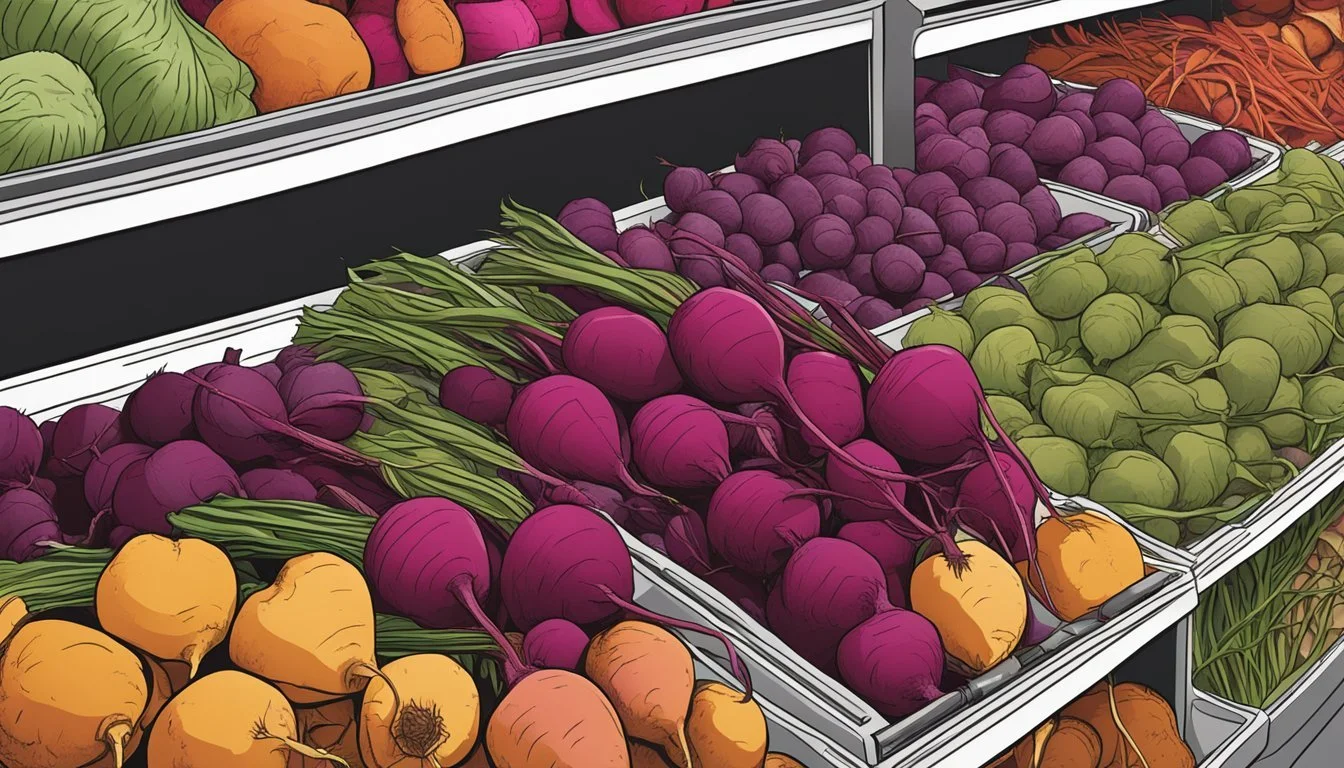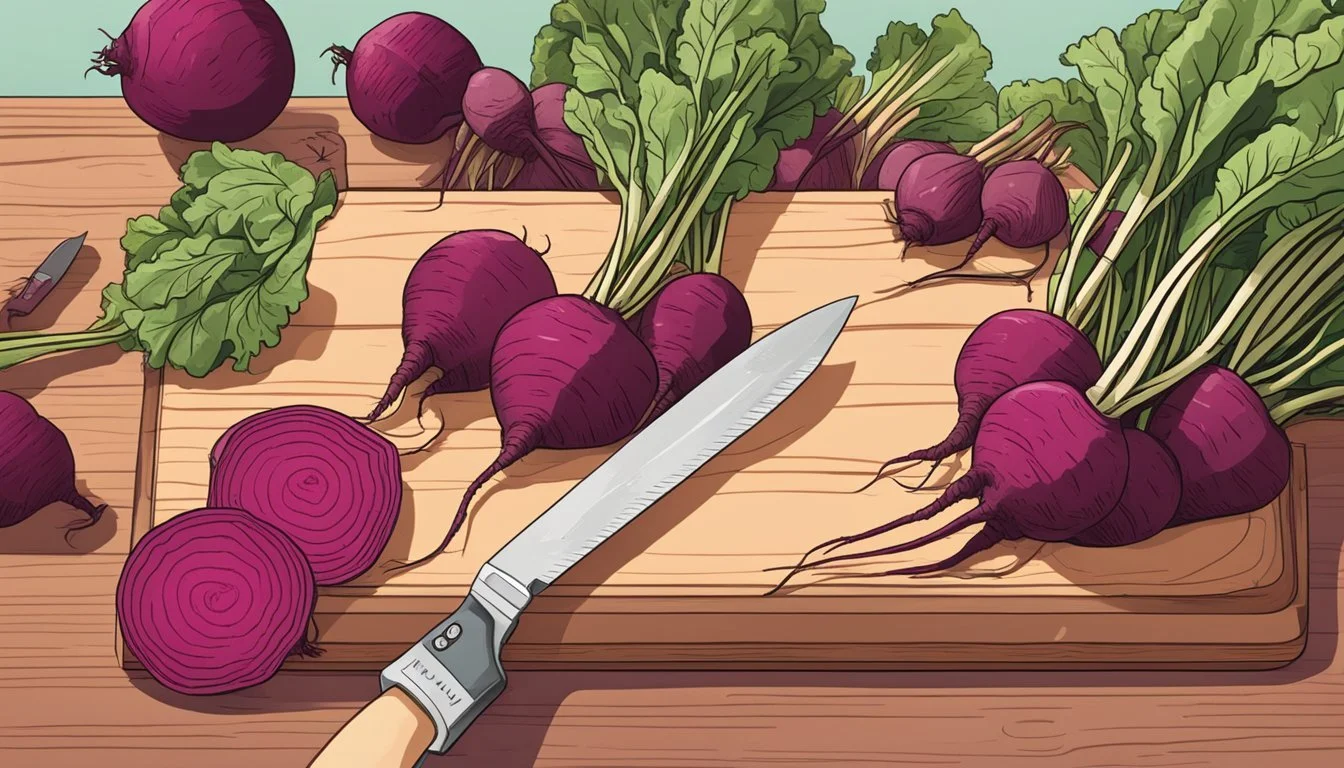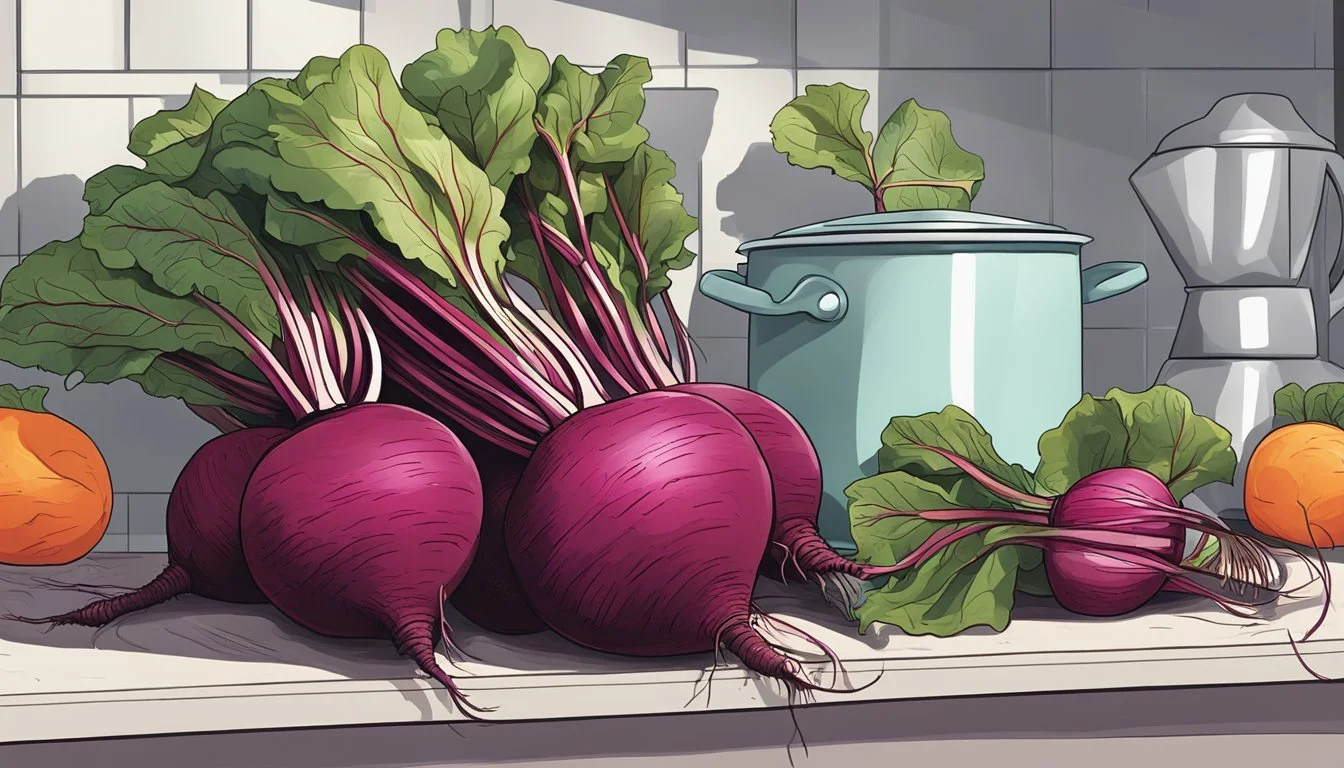How Long do Beets Last?
Understanding Shelf Life and Storage Tips
Beets (how long do beets last?) are a versatile root vegetable known for their earthy flavor and rich nutrient content. Recognizing how to properly store beets is essential for preserving their freshness and extending their shelf life. Fresh, uncooked beets can last for about two to three weeks when kept in a plastic bag in the refrigerator's vegetable drawer. It's important that they remain dry and unwashed until ready for use to prevent spoilage. Cooked beets, on the other hand, have a shorter lifespan and usually remain good for three to four days in the refrigerator when stored in a resealable container.
The longevity of beets can also be influenced by how they are prepared for storage. Beets with their greens attached should have the greens removed, leaving about an inch of stem, to reduce moisture loss from the root. The detached greens can be stored separately and enjoyed within a few days due to their more perishable nature. For longer storage, beets can be frozen. They should be spread out on a baking sheet to freeze individually before being transferred into a freezer-safe container or bag, which can keep them good for several months.
Understanding the subtle nuances of storing beets improves their shelf life and ensures that their taste, texture, and nutritional value are maintained. This can lead to reduced food waste and more efficient usage of beets in various culinary applications. Whether beets are stored in the refrigerator, freezer, or simply at room temperature for a brief stint, knowing these storage methods is invaluable for any beet enthusiast or home cook.
Identification and Selection
Selecting fresh produce is essential for quality and flavor, particularly when it comes to root vegetables like beets. This section offers guidance on how to choose the best beets from the produce section and what indicators of freshness and quality to look for.
How to Select Fresh Beets
When sifting through beets in the supermarket, one should look for firmness and unblemished skin. Fresh beets should feel heavy for their size, a sign that they are juicy and fresh. The size of the beet can vary and often depends on personal preference or the intended recipe, but beets that are uniformly sized are typically easier to cook evenly.
Firmness: Gently squeeze the beet; it should be hard and not give to pressure.
Skin: Opt for beets with smooth, unblemished skin. Avoid those with noticeable bruises or cuts.
Touching upon the variety, different types of beets may have varied firmness and skin characteristics. However, regardless of variety, the aforementioned qualities generally apply.
Recognizing Freshness and Quality
The freshness of beets can often be determined by inspecting the attached greens, if any. Fresh beet greens are vibrant and crisp, not wilted or yellowing. This indicates that the beets have been recently harvested and are likely to be fresh. Moreover, the quality of the root itself should not be ignored.
Greens: Look for bright, firm greens attached to the beets. They should be fresh-looking without any signs of spoilage.
Root: The beetroot should be firm and the skin taut, indicating it has retained moisture and is not old or dehydrated.
By paying attention to these details, shoppers can confidently select fresh, high-quality beets from the produce section of their supermarket or vegetable market.
Storage Fundamentals
Proper storage methods are critical for keeping beets fresh and extending their shelf life. Below are specific techniques for refrigeration and tips to retain the vegetable's freshness.
Refrigeration Techniques
Beets should be stored in the refrigerator to maintain their quality. Before placing them in the fridge, it's important to separate the beet greens from the roots. The greens should be wrapped in a slightly damp paper towel and stored in a plastic bag in the vegetable drawer of the refrigerator, where they can last up to three days. The roots, however, have a longer shelf life. They should be kept dry and unwashed in a plastic bag with a few holes for circulation, placed in the coldest part of the refrigerator, such as the crisper drawer. This method can keep the beets fresh for two to three weeks.
Preparation: Separate greens from roots.
Greens:
Wrap in moist paper towel.
Place in a plastic bag.
Store in the vegetable drawer.
Roots:
Leave dry and unwashed.
Put in a ventilated plastic bag.
Store in the crisper drawer.
Extending Freshness
To preserve beets for an even longer period, they can be kept in a dry, cool, and dark area—root cellars being ideal for this purpose. Proper storage in such an environment can maintain the beets' freshness for several months. For beets that have already been cooked, ensure that they are cooled completely before transferring them to an airtight container. These can be refrigerated and are best consumed within three to five days.
Raw Beets: Store in a cool, dark, dry space like a root cellar.
Cooked Beets:
Cool completely.
Transfer to an airtight container.
Refrigerate and use within three to five days.
By adhering to these storage fundamentals, one can keep their beets tasting sweet and remaining juicy for an extended period.
Preparation and Usage
Proper preparation of beets enhances their longevity and ensures they're ready for a variety of dishes. From fresh salads to hearty side dishes, the initial steps of cleaning and trimming are crucial for both storage and cooking.
Cleaning and Trimming
Before storing, one must rinse the beets to remove dirt, taking care not to damage the skin which can shorten their shelf life. Trim the greens, leaving about an inch of the stem attached. The leaves can be stored separately in the refrigerator and are excellent when sautéed or used fresh in beet salad.
Storing Greens: In a storage container, up to three days.
Whole Beets: Unwashed in a plastic bag in the fridge's vegetable drawer, up to three weeks.
Cooking Variations
Beets can be cooked in various ways, including roasted, steamed, or boiled, each method imparting its unique flavor profile.
Roasted Beets: Toss with olive oil and roast until tender.
Steamed: A gentle cooking method that preserves nutrients and color.
Boiled: Quick and easy but may lead to some nutrient loss.
Once cooked, beets should be consumed within three to four days when stored in a resealable container in the refrigerator. If longer storage is needed, cooked beets can be frozen.
Preservation Techniques
When storing beets for an extended period, freezing and canning are effective methods that can extend their shelf life significantly. Each technique has particular steps to ensure optimal preservation.
Freezing and Thawing
Freezing is a viable option to prolong the shelf life of beets. To freeze beets, one should cook them first until they are tender, which typically takes 25 to 30 minutes. Once cooked, they should be plunged into ice water to halt the cooking process. After peeling, the beets can be sliced, diced, or left whole and then placed on a baking sheet to prevent clumping. Once frozen, the beets should be transferred to airtight containers or vacuum-sealed bags to prevent freezer burn. This method can keep beets usable for up to ten months. They should maintain a consistent freezer temperature to avoid frost buildup and fluctuation that may affect their quality.
Steps to Freeze Beets:
Cook until tender.
Cool immediately in ice water.
Peel and cut as desired.
Arrange on a baking sheet and freeze individually.
Transfer to vacuum-sealed bags or airtight containers.
Label with the date and return to the freezer.
Pickling and Canning
Pickling and canning are traditional methods that enhance the taste of beets while also preserving them. For pickled beets, one must first clean and cook the beets similar to the pre-freezing process. Afterwards, they are sliced and placed in jars with a hot vinegar, salt, and sugar mixture. The jars should be sealed properly and processed in a boiling water bath to ensure they are adequately preserved. Canned beets can last for up to a year when stored in a cool, dark place. It’s important to assess canned goods before using them, looking for signs of spoilage which may include bulging lids or an off odor.
Steps to Pickle and Can Beets:
Prepare your beets by cooking and slicing.
Fill jars with beets and pickling solution.
Seal jars and process in a boiling water bath.
Check seals, then store in a cool, dark place.
Always check canned goods before use.
These preservation techniques not only extend the shelf life of beets but can also add variety to beet recipes through pickling spices and methods of preparation. Proper labeling with the date of preservation helps keep track of their freshness.
Beet Consumption Benefits
Beets, as nutritious root vegetables, offer a unique combination of sweet, earthy flavors and a treasure trove of health benefits that position them as an excellent addition to any diet.
Nutritional Information
Beets are packed with vitamins, minerals, and plant compounds that make them a commendable choice for maintaining a balanced diet. The following table outlines the key nutritional components found in beets:
Nutrients Amount per Half-Cup Cooked Beets Calories 37 kcal Fat 0 grams Cholesterol 0 milligrams Sodium 65 milligrams Carbohydrates 8 grams Dietary Fiber 3.8 grams Protein 1 gram
In addition to being low in calories and fat, beets contain high levels of fiber, which supports digestive health. They also boast a rich supply of antioxidants like betalains, responsible for their vivid color and numerous health-promoting properties.
Culinary Uses
Beets are versatile in the kitchen and can be used in a variety of dishes. They can be roasted to enhance their natural sweetness, boiled or steamed for a tender addition to salads, or pureed into a soup for a hearty side dish. Beet greens are also edible, adding a nutritious boost to salads or sautés. Their rich pigmentation makes them a visually appealing ingredient that enhances the aesthetic appeal of any dish.
Recognizing Spoilage
When beets begin to spoil, they exhibit clear signs that should alert a consumer to their deteriorating quality. It's crucial to recognize these signals to ensure food safety and avoid consumption of spoiled produce.
Signs of Spoilage
Beets that are starting to spoil often become soft and may develop limp or mushy areas. The appearance of mold is a definite indication that beets are no longer safe to eat. Additionally, they might exhibit an unpleasant smell, which is a telltale sign of spoilage. It’s important to inspect beets for these changes:
Softness: When pressed, a fresh beet should be firm. Any give or soft spots can signify the beginnings of spoilage.
Mold: Look for fuzzy, typically white or green, spots.
Smell: Fresh beets have an earthy scent. Any sour or off odors indicate they have gone bad.
Appearance: Discoloration beyond the usual variegated shades of the beet may suggest decay.
Safe Consumption
Determining whether beets are safe for consumption involves both visual and tactile examination based on the above signs.
Surface Inspection: Carefully examine the beet’s surface. If one sees mold, they should discard the beet to avoid health risks.
Firmness Test: Gently pressing on the beet can tell if it's firm. Softness, especially if pervasive, would mean it is time to throw them away.
Smell Check: An odor test can help detect spoilage not visible to the eye.
Examine for Limpness: Beets that feel limp and not crisp and taut indicate they are past their prime.
If any of these signs are present, it is recommended to discard the affected beets to prevent the risk of foodborne illness.
Beet Varieties and Characteristics
Beet varieties vary widely in color, taste, and optimal growing conditions. Understanding these differences is crucial for gardeners and cooks alike to select and utilize beets to their full potential.
Color and Taste Profiles
Red Beets: Traditional red beets have a deep crimson hue and a rich, earthy flavor. They are high in natural sugars and can add a bold color to dishes.
Golden Beets: Golden or yellow beets feature a vibrant yellow flesh with a sweeter and milder taste compared to red beets.
Chioggia Beets: Also known as candy cane beets, they display concentric white and red rings and possess a slightly peppery taste.
Nutritional Profile: Both red and golden beet varieties are nutritious, offering vitamins and minerals such as Vitamin C and iron. Beet tops, similar in nutritional value to chard and kale, are rich in Vitamin A.
Selection Tips
When selecting beets, one should look for firm, smooth roots and vibrant, un-wilted greens, if still attached. Smaller beets tend to be more tender and sweeter, making them ideal for raw preparations like salads, whereas larger ones are better suited for cooking. It is recommended to choose beets that are uniform in size for consistent cooking results.
Garden Harvest: Beets are ready for harvest approximately 50-70 days after planting. Signs of maturity include the root pushing up through the soil and leaf yellowing.
Market Selection: At the market, find beets with intact root tips and a small amount of stem, as these are indicators of freshness.
Selecting the proper variety and understanding the characteristics of beets ensures the best use in culinary applications and maximum enjoyment from garden to table.
Conclusion
Beets are highly versatile and nutritious root vegetables with a notable shelf life when stored properly. Raw beets can last up to three weeks when kept unwashed in a plastic bag in the fridge’s vegetable drawer. It is advised to trim the greens, leaving an inch of the stem, to prolong freshness.
State of Beets Fridge Life Expectancy Raw Beets Up to 3 weeks Cooked Beets 3 to 4 days Beet Greens Up to 3 days
Upon cooking, beets should be allowed to cool for about an hour before being placed in a sealed container in the refrigerator where they will last for a shorter period of 3 to 4 days. To extend the usability of beets beyond these timeframes, freezing is an excellent option. Frozen beets can maintain their quality for up to 8 months.
Consumers should be aware of the signs of spoilage, which include a soft texture, an off smell, and discoloration. For optimal flavor and nutritional value, it is best to use beets within these recommended time frames. Proper storage is essential to maximize the shelf life and maintain the quality of beets.









